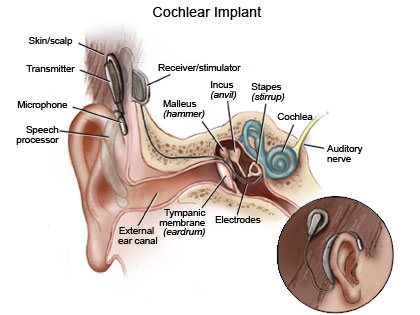Giraud et al. (2001)
From Psy3242
Mcdlizzie87 (Talk | contribs) (→Summary) |
Mcdlizzie87 (Talk | contribs) (→Shorter Version of Summary) |
||
| Line 15: | Line 15: | ||
== Shorter Version of Summary == | == Shorter Version of Summary == | ||
''Purpose'': This Study was to test the recruitment of their visual cortex when hearing verbal cues in cochlear implant patients. These patients were tested at different times after they got their implants. | ''Purpose'': This Study was to test the recruitment of their visual cortex when hearing verbal cues in cochlear implant patients. These patients were tested at different times after they got their implants. | ||
| + | |||
''Results:'' The visual cortex was activated in trained cochlear implant patients where in the control group it was not active. They also figured out that the visual field was active do to specific stimuli. (1) they do so more than control subjects, (2) activation increases the longer they use an implant, and(3) they do so in a progressively stimulus-specific way. | ''Results:'' The visual cortex was activated in trained cochlear implant patients where in the control group it was not active. They also figured out that the visual field was active do to specific stimuli. (1) they do so more than control subjects, (2) activation increases the longer they use an implant, and(3) they do so in a progressively stimulus-specific way. | ||
---- | ---- | ||
Link to article: [http://blackboard.rollins.edu/courses/1/10301.PSY324.1.200801/content/_175427_1/Giraud_2001_Human_cochlear_implant_Neuron.pdf] | Link to article: [http://blackboard.rollins.edu/courses/1/10301.PSY324.1.200801/content/_175427_1/Giraud_2001_Human_cochlear_implant_Neuron.pdf] | ||
Revision as of 03:33, 29 April 2008
Summary
When people who can hear listen to someone speak while looking at them, there visual cortex areas V1 and V2 are not activated. However, when people try to silent lip-read the auditory regions A1 and A2 are stimulated: indicating that the neighboring neurons of the auditory cortex are recruited and form a cross- model cooperativity that enables the brain to best interpret the visual input when there is a lack of auditory input.
In this study a kind of inverse of the previously mentioned finding was demonstrated. In this study the variable participants were deaf subjects who had learned the meanings of sounds after cochlear implantation (on average they had about 18 cochlear implants). Because the cochlear implants only enable the subject to hear and hardly detect fine discrepancies in sound (such as the difference between park and dark), they must rely on visual cues (like lip reading) to form associations between sounds and their meanings. What it is like to hear with cochlear implants
In the experiment the visual regions V1 and V2 were active during auditory tasks when the cochlear subjects' eyes were closed. The amount of activation in these visual regions was directly related to the amount of time the subject had been living with cochlear implants, as well as the subject's proficiency in lip-reading. Furthermore, a control group of hearing patients did not demonstrate activation of visual regions when hearing verbal cues.
This study emphasizes two important aspects of neuroplasticity. One, that the brain will donate/recruit neighboring neurons to better interpret sensory input, and that this cross modality between neighboring regions of the brain is strengthened with experience (neurons that fire together wire together).
Shorter Version of Summary
Purpose: This Study was to test the recruitment of their visual cortex when hearing verbal cues in cochlear implant patients. These patients were tested at different times after they got their implants.
Results: The visual cortex was activated in trained cochlear implant patients where in the control group it was not active. They also figured out that the visual field was active do to specific stimuli. (1) they do so more than control subjects, (2) activation increases the longer they use an implant, and(3) they do so in a progressively stimulus-specific way.
Link to article: [1]

